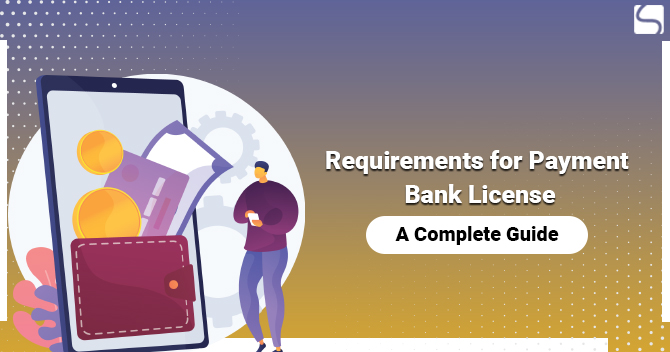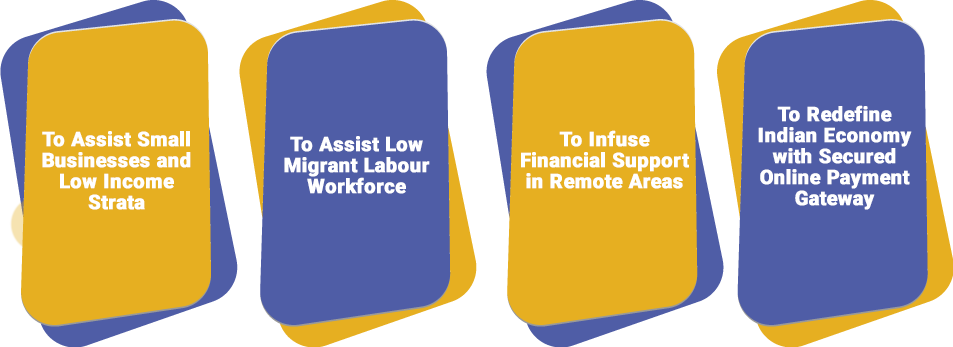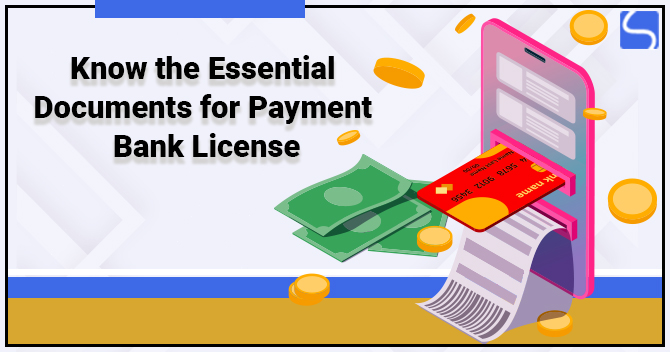Requirements for Payment Bank License: A Complete Guide

Shivani Jain | Updated: Feb 16, 2021 | Category: Payment Bank License
The dynamics of Indian Economic System have completely changed after Demonetization. People now rely more on paperless transactions and prefer to use digital payment portals instead of the traditional method. Therefore, the same has given an immediate boost to Mobile Wallets or E-wallets that were outcast earlier. Further, the primary niche of such digital gateways is payment banks. To start an online gateway in India, one needs to satisfy the requirements for Payment Bank License.
In this blog, we will discuss about the concept and requirements for Payment Bank License in India.
Table of Contents
Concept of Payments Bank in India
The term Payments Bank denotes a new bank model that was started by the RBI in the year 2014. These banks can accept a restricted deposit of maximum Rs 1 lakh per customer, which will increase further.
Although these banks are an addition to the banking sector, but they do not offer issuance of loans and credit card facilities. Normally, a payment bank offers a series of services, such as ATM Cards, Debit Cards. But, after satisfying the requirements for Payment Bank License and obtaining it, an entity can work on current and saving accounts as well.
Further, based on the provisions of the Banking Regulations Act 1949, it is mandatory for a payment bank or a differentiated bank to allow the establishment of new outlets, such as ATMs (Automated Teller Machines), BCs (Business Correspondents). However, the same cannot indulge in the activities undertaken by a bank.
Also, it shall be considerate to take into consideration that the minimum paid up capital needed to start a payment is Rs 100 crores or more.
Also, Read: Top 5 Best Payment Gateway Systems in India
Objective of Payments Bank in India
The key objectives of a Payment Bank in India are as follows:

- To Assist Small Businesses and Low Income Strata;
- To Assist Low Migrant Labour Workforce;
- To Infuse Financial Support in Remote Areas;
- To Redefine Indian Economy with Secured Online Payment Gateway;
Features of Payments Bank in India
The key features of Payments Bank License in India are as follows:

- Provides Deposit up to Rs 1 lakh;
- Offers both Physical and Virtual Credit Cards;
- Smoothens out the Process of Receiving Money through Digital Platforms;
- Eliminates the Need of Conventional Banks;
Regulatory Framework for Payment Banks in India
The laws governing the operations of Payment Bank in India are as follows:
- Companies Act 2013;
- Banking Regulation Act 1949;
- Reserve Bank of India 1934;
- Foreign Exchange Management Act 1999;
- Payment and Settlement System Act 2007;
- Deposit Insurance and Credit Guarantee Corporation Act 1961;
Who are all Eligible to Obtain Payments Bank License in India
The ones eligible to obtain Payments Bank License in India are as follows:
- Individuals/ Professionals;
- Mobile Telephone Companies;
- NBFCs (Non-Banking Financial Companies);
- Real Estate Sector Cooperatives;
- Supermarket Chains;
- PSUs (Public Sector Entities);
- Any Promoter or a Group of Promoters, who have a JV (Joint Venture Agreement) with an existing Schedule Bank;
- Existing Non-bank PPI (Prepaid Payment Instrument) under the provisions of the Payment and Settlement Systems Act 2007;
- Public Companies;
- Corporate Business Structures;
Examples of Payment Bank in India
Some of the famous examples of Payments Banks in India are as follows:
- Airtel M Commerce Private Ltd;
- National Securities Depository Limited (NSDL);
- Fino Pay Tech Ltd;
- Vodafone M Pesa Limited;
- Distribution Service Limited;
- Reliance Industries Limited;
- Paytm Payments Bank;
- Tech Mahindra Limited;
- Department of Post Aditya Birla Nuvo Limited;
Capital Requirements for Payment Bank License
The capital requirements for Payment Bank License are as follows:
- Must have Rs 100 crores as the Minimum Paid-up Equity Capital;
- Need to maintain 15% as the Minimum Capital Adequacy Ratio of the Risk Weighted Assets (RWA). The same is subject to any higher percentage as timely prescribed by RBI;
- Tier I capital must be at least 7.5% of the total Risk Weighted Assets;
- Tier II capital must be limited to a maximum of 100% of the Tier I capital;
- Not allowed to deal in sophisticated products. That means the Capital Adequacy Ratio is calculated based on the Basel Committee Standardised Approaches;
Detail Requirements for Payment Bank License
The detail requirements for Payment Bank License in India are as follows:
Details of an Individual Partner
The details required from an individual partner include as follows:
- Promoter’s Name;
- Date of Birth;
- Parents Name;
- Residential Address;
- PAN (Permanent Account Number);
- Bank Account Details, together with Branch Name and Credit Facilities;
- Experience and Qualification of Individual Partner;
- Areas of Expertise;
- Business Track Record and Financial Worth;
Details of the Entity Promoting Bank
The details required from such an entity are as follows:
- Shareholding Pattern of the Promoter Entity;
- A copy of the MOA and AOA of the Entity;
- Financial Statements of the previous five financial years;
- Income Tax Return of the previous three financial years;
Details of the Entity and Individuals in the Promoter Group
The details required from such an entity and individuals are as follows:
- Name of the Entities in the Promoter Group;
- Name of the Individuals in the Promoter Group;
- Shareholding Pattern;
- Management Details;
- Details of the Total Assets;
- Pictorial Organogram;
- Annual Report for the previous five financial years;
- Details concerning the Shares Listed in the Recognised Stock Exchanges;
- PAN (Permanent Account Number) details;
- CIN (Company Identification Number);
- TAN (Tax Deduction & Collection Account Number) details;
- Bank Account and Branch Details;
Business Plan Requirements for Payment Bank License
The Business Plan Requirements for Payment Bank License are as follows:
- The applicant company needs to submit their Business Plans, Project Report, together with Applications;
- The Business Plan must discuss about the ways by which the bank proposes to achieve its purposes and objectives of setting up payments bank;
- Business Plan must be Accurate and Practical in Nature. Also, it shall be noteworthy to take into note that, out of all the applications, first preference will be given to those who will establish their access points in the underdeveloped states and districts, such as East, Central, and North-East regions of the nation;
- It shall be obligatory for a Payments Bank to extend the network of the access points in the remote areas, either by way of Business Correspondents or through their own Branch Network or the Networks provided by other;
- Every Payment Bank needs to adopt Technological Solutions to extend its reach, network, and lowers cost as well;
Post Registration Requirements for Payment Bank License
The post registration requirements for Payment Bank License are as follows:
- Not allowed to accept NRI Deposits;
- Need to maintain the Minimum Paid up Capital of Rs 100 crores;
- Can provide ATM or Debit Cards to Clients;
- Cannot offer Loan and Visa Administrations;
- Allowed to accept Current Deposits;
- Allowed to accept Investment Fund Bank Deposits from Private Ventures up to a prescribed threshold;
- Need to accept the listed RBI Compliances on the mandatory basis:
- Data Security;
- Cyber Laws;
- Electronic Banking and Technology Risk Management;
- Must use “Payments Bank” as a suffix, to differentiate itself from traditional banks;
Conclusion
In a nutshell, Payments Bank means a new bank model implemented by the Apex Bank in the year 2014. This business structure offers a series of services, such as ATM Cards, Debit Cards. However, it shall be noteworthy to state that it is not allowed to offer loans and credit card facilities.
The main reason behind the introduction of this concept was to assist Small Businesses, Migrant Labour Force, and Low Income Strata, and to infuse Financial Support in Remote Areas, which will ultimately help in the process of redefining Indian Economy. Further, to start a Payments Bank in India, the applicant company needs to satisfy the above mentioned complex and intricate formalities and responsibilities. At Swarit Advisors, we have a team of expert who will cater to all your doubts and queries and will assist in the process of obtaining Payment Bank License in a hassle free and straight forward manner.
Also, Read: Meaning and Process of Online Payment Gateway in India 2020













